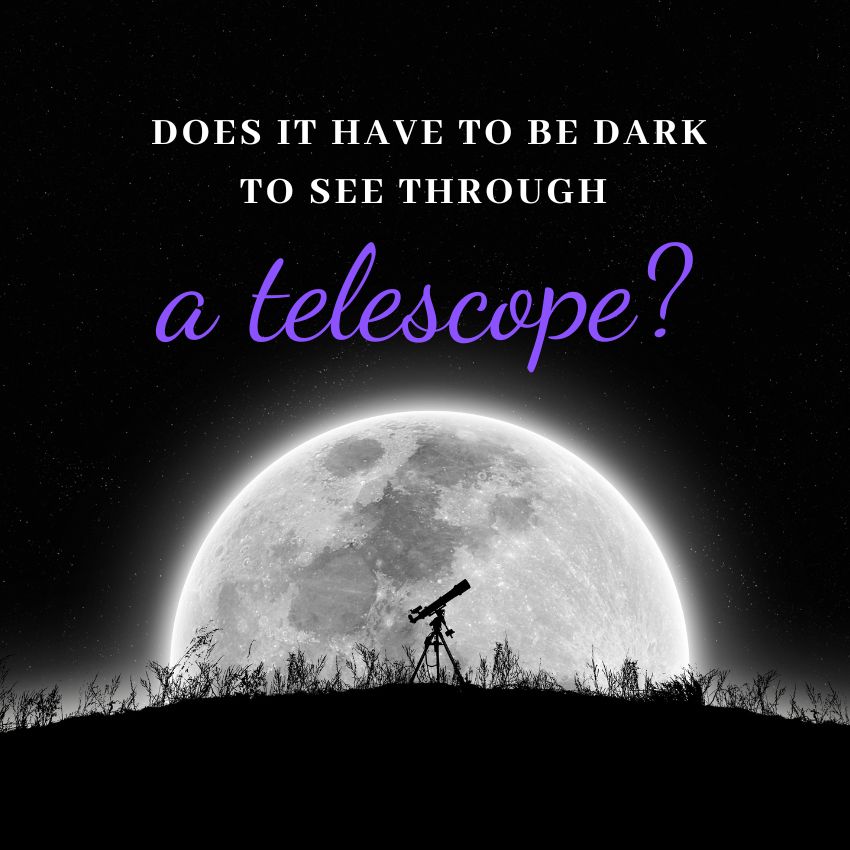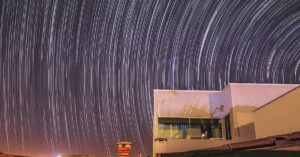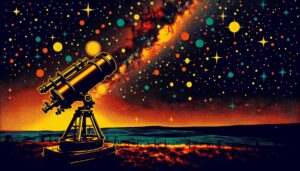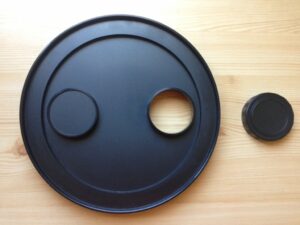This site contains affiliate links to products. I may receive a commission for purchases made through these links.
A telescope is one of the many tools that make stargazing fascinating. It is indispensable for those looking to be introduced to a new world of unique and unexpected wonders in space. But must you wait till it’s dark to see through a telescope to enjoy these vast wonders?
A telescope works during the day and at night, so it doesn’t have to be dark to see through it. However, it’s more effective for stargazing at night than it is during the day, and rightly so. Sky objects shine brighter at night than in the day.
A telescope typically works by gathering light from distant deep-sky objects. These objects are then magnified, making them visible to the naked eye. But how do you enjoy this function during the day without the interference of sunlight?
This article explores essential things to know to use your telescope during the daytime and at night.
Can I use a telescope during the day?
You can use a telescope for stargazing and other daytime observations. This may include viewing landscapes, wildlife, and airplanes, amongst many others. However, certain factors and limitations guide its usage during the day.
Daylight sun gazing using a telescope has a critical limitation you must know. Using the telescope to observe the sun during the day exposes your eyesight to dangers you may live to regret. The good news, however, is that you can avoid this danger by using a solar filter.
The solar filter is a telescope accessory that shields the eyes from the harsh effect of direct sunlight. It works by reflecting off most of the heat and light before it arrives in the tube.
The best solar filter for under $30 is this 10”x10” plastic solar filter.

Check the current price on Amazon
With this filter, only 0.001% of the sun goes through the telescope when you’re using it.
Another limitation affecting the use of telescopes during the day is that only a few planetary objects are visible. While you can see some of them without help, others can only be seen under the right conditions with supervision.
So as a beginner, you may need to tag along with some experienced stargazers to enjoy this activity.
What are the celestial objects that can be observed with a telescope during the day?
Apart from the obvious ones like the moon and the sun, other celestial objects observed with a telescope during the day include planets, lunar eclipses, solar eclipses, comets, double stars, meteor showers, satellites, and terrestrial landscapes.
The moon
The Moon is the only satellite available to the Earth and is a fascinating celestial object for observation.
Stargazers who own small telescopes can see most of the Moon’s features the same way as those with larger telescopes.
Additionally, under good weather conditions, you can see newer details of the moon’s surface every time you observe.
The Sun
The Sun is an important celestial object visible through the telescope during the daytime.
However, to observe it during the day, use a solar filter explicitly approved for this purpose. Once a solar filter is fixed in your telescope, you can observe sunspots daily while enjoying its rotation.
Planets
Many people are only familiar with the pictorial representation of solar system planets. But with a telescope like Celestron, you can observe them during the daytime. While they will likely look smaller and less bright, you’ll still enjoy seeing them.
Venus is the brightest of these planets, apart from the Sun and the Moon. That’s why it is called the morning star. Like other planets in the solar system, it is visible during the daytime using a telescope.
It has a surface brightness that glows through the reflection of the Sun.
Contemplating a great telescope option to observe planets? This compact Celestron telescope offers you a remarkable experience.

Check the current price on Amazon
Lunar eclipses
Eclipses are a fascinating event for skywatchers around the world. It happens when the sun moves between the sun and the moon, creating a shadow that spreads across the lunar surface.
While you don’t require any equipment to watch it, it gets more visible and enjoyable using a telescope.
The next lunar eclipses are expected on May 5 (penumbral eclipse) and October 28 (partial eclipse), 2023.
Solar eclipses
Solar eclipses occur when the Moon gets in between the Earth and the Sun. As a result of this movement, the moon casts a shadow across the face of the Earth.
You’ll need a telescope to view the solar eclipse when it happens safely. It is projected to happen on April 20 (total) and October 14 (annular), 2023. But be sure your solar filters are installed before using the telescope.
Anticipating the solar eclipse? You’ll need this long-reaching and eye-friendly Hexeum telescope with impressive astronomical features.

Check the current price on Amazon
Comets
Comets are giant snowballs, typically consisting of frozen glasses, dust storms, and rocks, orbiting the sun. They are as big as a small town, with some known and others unknown. The current number of comets that are known is 3,743.
They randomly appear in any direction, and you can see them with a telescope. You can also see their ever-changing nature, which may last months with their dust and ion tails as they move eccentrically around the sun.
Double stars
As its name suggests, double stars are two close stars in the sky. They appear as gravitationally bound and vice versa. Those gravitationally bound are known as binary star systems, while those that aren’t are known as optical doubles.
The fact that double-star systems are different makes observing them fascinating. With your telescope, you’ll see a wide range of stars with their distances and differences.
Meteor showers
Meteor showers are visible when crumbs of comets or asteroids enter the Earth’s atmosphere. They move at a remarkably high speed while rubbing against air particles, resulting in heat and friction.
After this, the heat vaporizes making the meteors visible to the naked eye as shooting stars or bright streaks of light.
You can see some of them with your bare eyes. But you can enjoy their movement with a telescope till they go out of sight.
Satellites
Satellites are artificial machines launched into space orbiting the Earth and other bodies.
They are in different sizes and are visible if you know where to look. However, with a good telescope, you can see them from anywhere.
Terrestrial landscapes
As mentioned earlier, telescopes are used for more than just space observation.
They are also used as spy glasses to observe terrestrial landscapes and other Earth-based objects from afar.
What objects can be observed at night with a telescope?
Most objects in space are much more visible under dark skies. But their visibility is enhanced with dark adaptation before you see them with a telescope.
The following are examples of objects you can observe under a dark sky using a small telescope:
Stars
You can observe stars under the night sky without using a telescope. However, telescopes allow you to peer into the brightest stars to see their beauty and color.
With the naked eye and a normal visual acuity, you’re likely to see 10,000 stars at night under a dark sky, but you can see about 50 million of them with a telescope.
Star clusters
These are groups of stars that are gravitationally bound. You may see open clusters with the naked eye. But with a telescope under a low light, you can fully experience their beauty and form.
Galaxies
Galaxies are distant objects you can observe under dark skies with a telescope. But you must use a large aperture telescope with a minimum of 8 inches to see brighter galaxies.
This kind of telescope lets you observe their brightness, shape, and other deep-sky objects around them.
You can get this bestseller SVBONY SV48P Telescope telescope with a large 90 mm aperture.

Check the current price on Amazon
Nebulae
Nebulae are big clouds that contain dust, hydrogen, and other gases in space. With a refractor telescope, you can observe planetary nebulae and other deep-sky objects under truly dark skies.
They are called planetary nebulae because they appear similar to planetary disks.
Global clusters
Global clusters, similarly known as globular clusters, are the oldest and most prominent type of star clusters.
They are tightly packed and easily one of the most beautiful objects to see through a telescope. You can observe the globular clusters at night with a small telescope.
Open clusters
Compared to global clusters, open star clusters are younger and sparsely populated stars loosely bound together. Open clusters are found in tens of thousands around irregular and spiral galaxies.
This type of star cluster may be visible to the bare eyes irrespective of visual acuity. But with a small telescope, you can enjoy seeing how the stars cluster together.
Variable stars
Variable stars are those with periodic or irregular changes in brightness. These changes can be instantaneous or may take years. But whenever they occur, their brightness is altered.
One hundred thousand of them, including our Sun, are known and have been cataloged.
Other deep sky objects you can see at night that are also visible during the day using a small telescope include the following:
- Double stars
- Planets
- Comets
- Meteor showers
- Satellites
- Lunar eclipses
- Terrestrial landscapes
Benefits of daytime observing with a telescope
Stargazing, in its entirety, is an exciting activity that’s enjoyable during the day as much as it is at night under truly dark skies.
Stargazing during daytime observing planetary objects while using a small telescope comes with some benefits, which include the following:
Better visibility of objects due to increased contrast
Observing the sky and other celestial bodies during the day enhances visibility. Daylight offers increasing contrast, making light and dark areas lighter.
Using your small telescope during the daytime helps identify all features of whatever you’re observing during the day. While it’s the same under dark skies, you may not have enough contrast.
You may also learn how to increase the magnification of your telescope to maximize its visibility.
Reduced light pollution
Light pollution typically drowns light from faint objects in the sky. While the brightest stars may resist light pollution, the same can’t be said of less bright stars.
That’s why the surge in artificial lights that shine in the suburban sky at night causes light pollution for stargazers and astronomers. They usually need dark adaptation to make the most of their experiences.
So to avoid light pollution, you must try observing with a telescope in the daytime. Doing this allows you to concentrate on whatever celestial object you want to observe without dealing with stray lights and other light pollution.
Less impact on sleep patterns
Traditionally, stargazing is known to be a nighttime affair under dark skies. Stargazers go to night camps and stay up late to be able to catch sight of the objects in the sky.
This can disrupt sleep patterns, and that’s why daytime observation is beneficial.
Daylight astronomy is also fun, especially for children and young adults. It allows you to observe the appearance of objects in the sky while marking the difference between daytime appearance and night appearance.
Familiarizes beginners with a telescope
A stargazing beginner doesn’t need to be an experienced observer or take intensive training to use telescopes. But there is rudimentary knowledge to acquire to enjoy the sky and solar observation.
Their familiarity with the telescope can be done and enjoyed during the day.
They can learn how to set the tool, install its accessory, and identify where to look to pick out targeted deep-sky objects. So once they acquire this knowledge, it’ll serve as a foundation for their nighttime stargazing.
But you’ll need a great telescope to get this beautiful stargazing experience.
You may want to read up on whether a cheap telescope is worth it.
Great way to spot terrestrial objects
Terrestrial objects like landscape and wildlife observation are another fun part of daytime observing with a telescope. By positioning the telescope at specific locations, you can closely observe the natural world in your immediate environment.
You can watch birds and aquatic creatures as they fly and swim, respectively. You can get a closer look at multiple features that are far distances and invincible to the naked eye.
Opportunity to observe the Moon, the Sun, and bright planets
While it’s established that the Moon and the Sun are bright enough to be seen during the day, there are other bright planets. For example, Venus, Jupiter, and Saturn are easily seen early in the morning using a telescope.
The major challenge is finding where they are in the daytime sky. If you’re not under the supervision of an expert, you can explore mobile apps and planetarium softwares to help you spot them.
You may also like: How Big of a Telescope Do You Need to See Saturn’s Rings?
Spot international space station
Daytime observing with a telescope also allows you to spot the international space station.
The space station is bright and appears as a fast-paced star in the sky. It’s always fabulous to see using a telescope, regardless of time.
However, you may need to time your observation because the station orbits around Earth. To make that easier, you can spot the station using a tracker from anywhere.
You may also like: Can Telescopes Look Back in Time? (Answered!)
Tips for a safe daytime observation with a telescope
Observing every celestial object with a telescope is a fantastic experience. However, doing it during the daytime poses specific threats to the eyes.
That’s why it’s crucial to observe and prioritize all safety tips for daytime observation, some of which include the following:
Use proper filters for safe observation of the Sun
The solar filter for observing the sun must be installed onto the objective, not the eyepiece. Failure to do this can expose the eyes to the dangers of direct sunlight.
Nobody can afford to see the Sun directly without hurting their eyes. The same thing applies while using a telescope.
That’s why you need this durable and safe Celestron filter for the Sun.

Check the current price on Amazon
Observe during partial eclipses for a better view of the sun
Partial eclipses occur when the part of a celestial object doesn’t align perfectly in a straight line with others. Observing the sun at this time offers you a better view of its features.
A telescope with higher magnification will allow you to see the movement of other objects as they go in between one another.
Proper alignment and focus for observing the moon and planets during the day
You must also ensure proper alignment and focus of the telescope during daytime observation.
Balance the objective and eyepiece because both define your observation’s optical characteristics.
Use a polarizing filter to reduce glare and improve contrast
The best way to manage reflections while observing with a telescope is to use a polarizing filter. This filter improves contrast, allowing you to suppress glare.
Once installed, you get top-notch pictures from your observation.
Avoid direct sunlight on the telescope and eyepiece to reduce heat distortion
Heat distortions are bad for your telescope as they can affect the optics. The optics lose their ability to bring light to a sharp focus during observation.
This results in a bad performance, so you must avoid exposing your telescope to direct sunlight.
Failure to do this leads to blurry planetary details, degrading contrasts in detailed sky objects, and poor experience during observation.
Use a telescope cover to protect the telescope from the sun
Shielding the telescope from the Sun is one of the best ways to retain its best performance.
While it may seem like a bit of detail, prioritizing it would retain the telescope’s longevity and operationality.
With a telescope cover, you can protect the telescope when unused. It’s a unique cover that’s coated to protect the telescope from dew buildups and UV rays.
Use a tripod or mount to steady the telescope
Stability is crucial to enjoying every observation using a telescope. That’s why you need a tripod or mount to steady the telescope.
To achieve the balance you want, ensure you install the accessories properly.
Telescopes don’t only magnify what they see; they also magnify every vibration and wobble. These may affect the optical quality of your observation. So you must install the tripod or mount it properly.
Use the right eyepiece for the best view and magnification of the objects
As great as having a quality objective lens is, it’ll only be possible to get a fine detail of a sky object with the right eyepiece. Eyepieces carry as much importance as the telescope itself.
A low-power eyepiece will likely give you low image quality during daytime or under low light. So to get more detail from your observations, you have to choose the right one with the right quality to get the best experience.
Use good-quality lens coatings to prevent glare and improve image quality
A high-quality lens for your telescope means images are larger, more precise, and brighter. But to enhance image quality, you need lens coatings.
Good quality lens coatings ensure lights are evenly transmitted through the telescope. Additionally, they also reduce glare, all to get image sharpness and excellent contrast while observing.
For more info on telescopes, subscribe to Telescope Guides Newsletter.Takeaway: Enjoy a remarkable experience with both day and night telescope observation
Daytime observation using a telescope is a sure way to optimize your stargazing experience without losing sleep. Despite that, it has its challenges, it’s as fun as night observation, and that’s something to look forward to.
Whether you’re a beginner in stargazing or astrophotography, a telescope offers you some realities of the objects in space. Irrespective of the time you decide to use it, you will surely enjoy a remarkable experience.
Read also:




